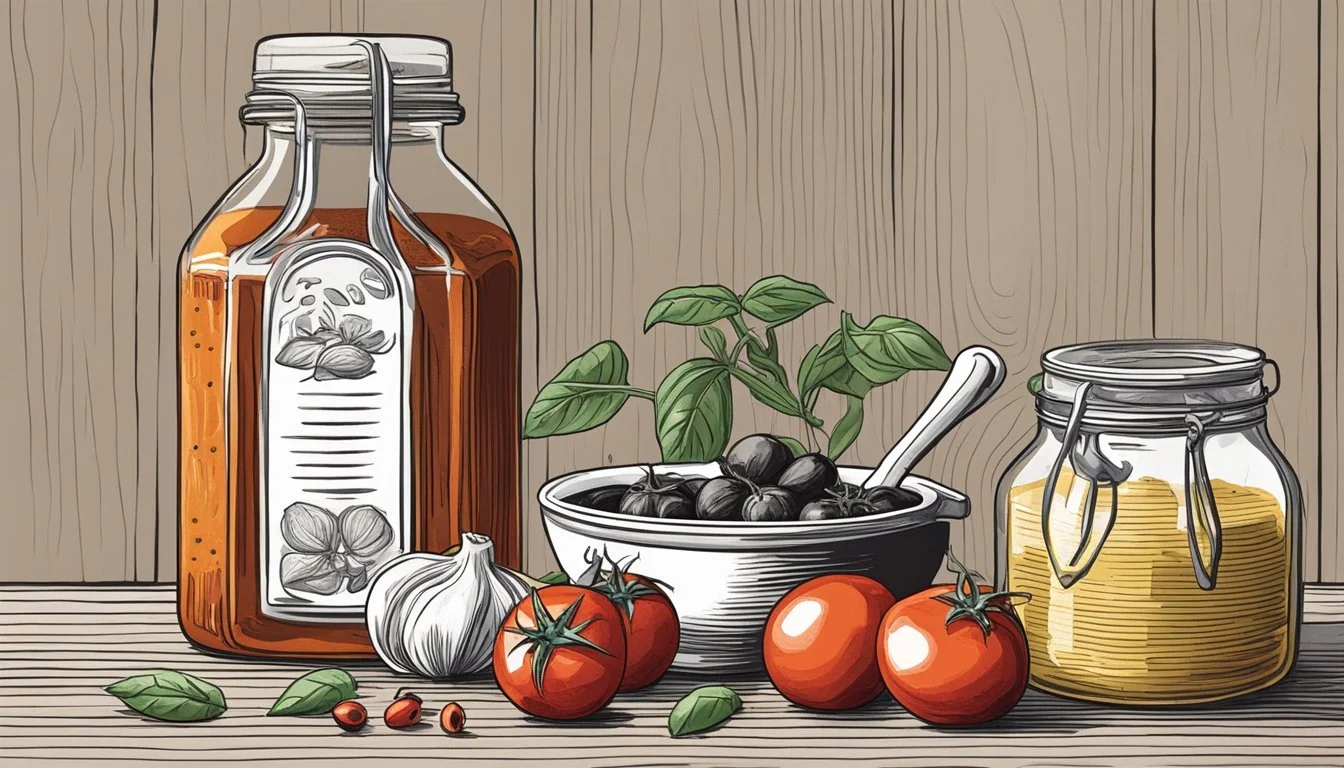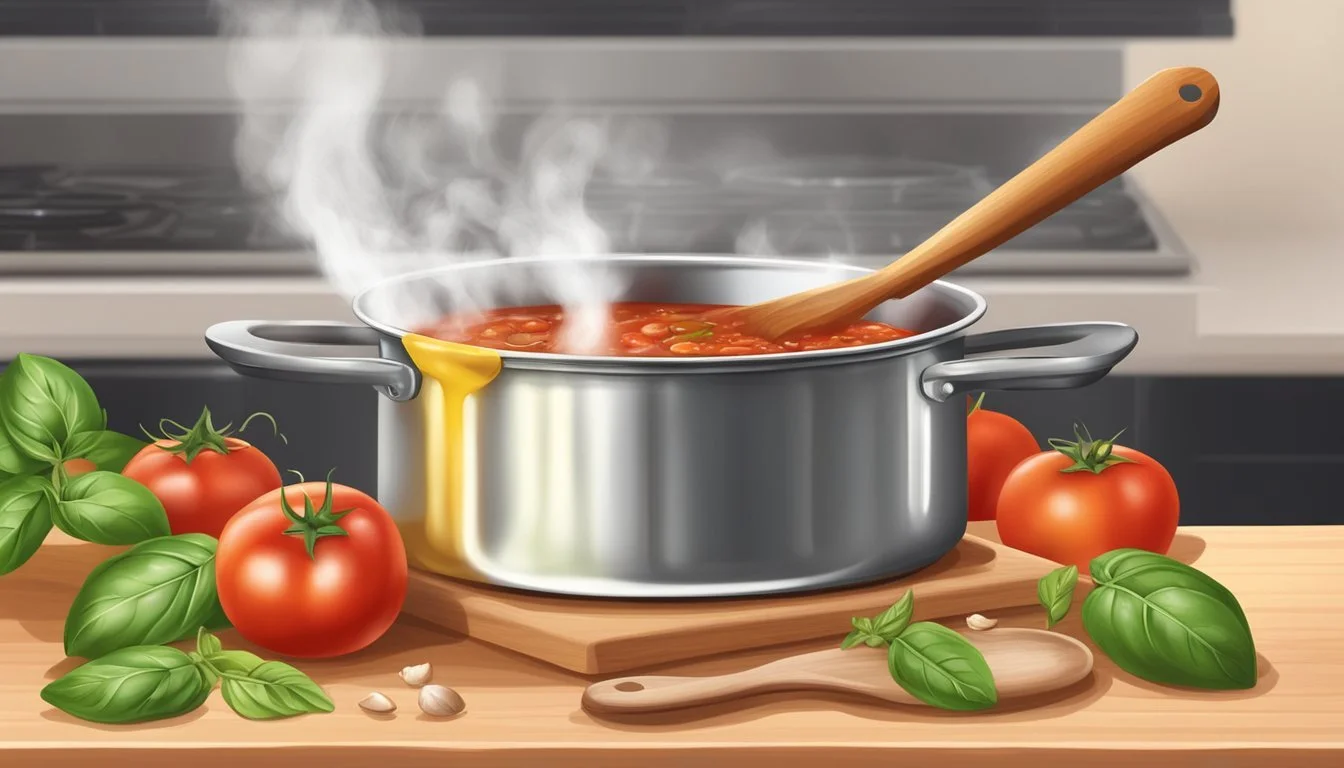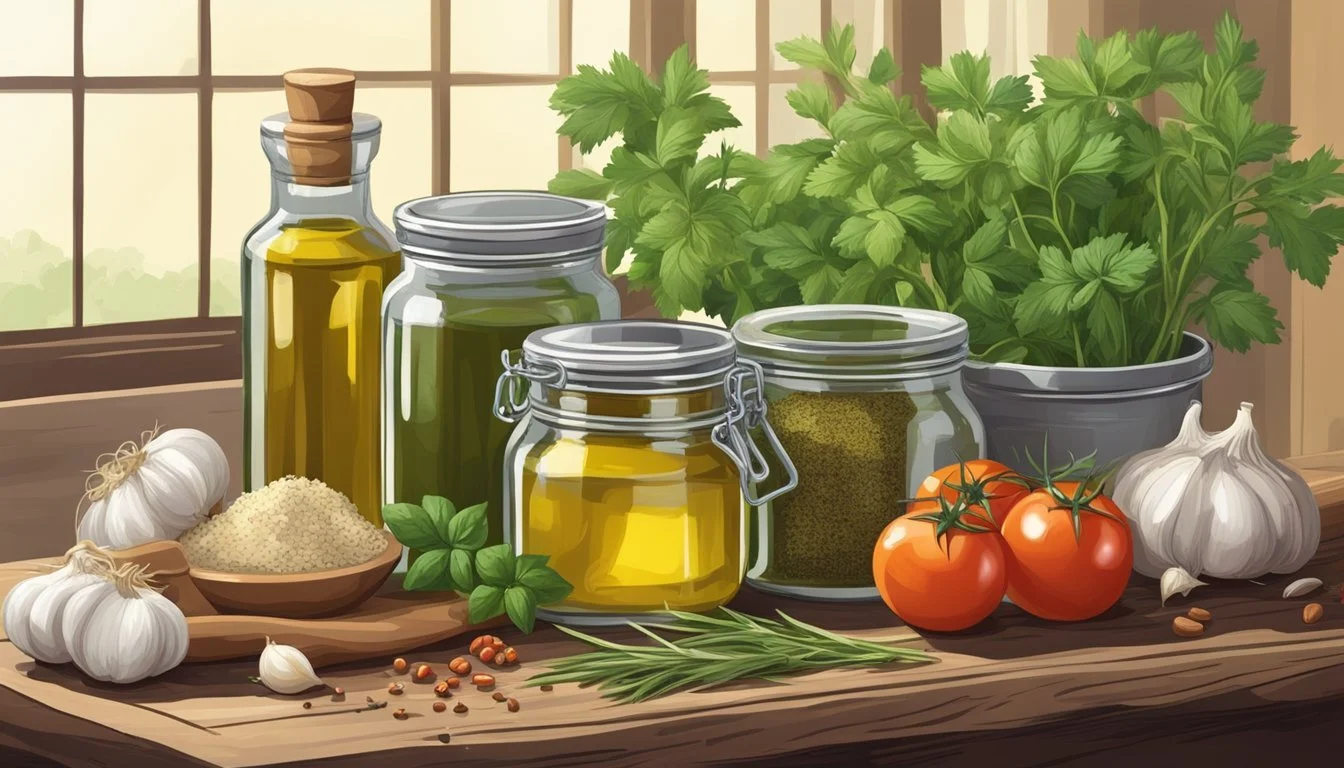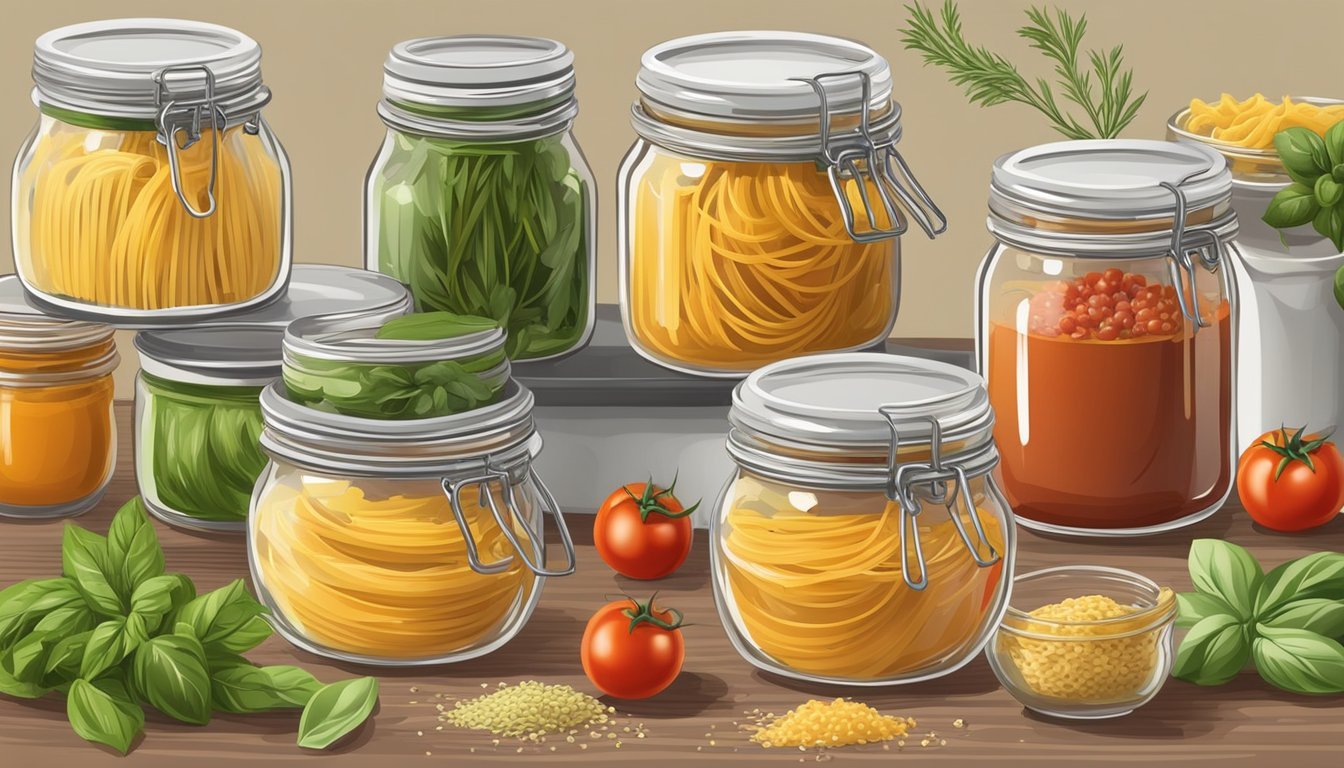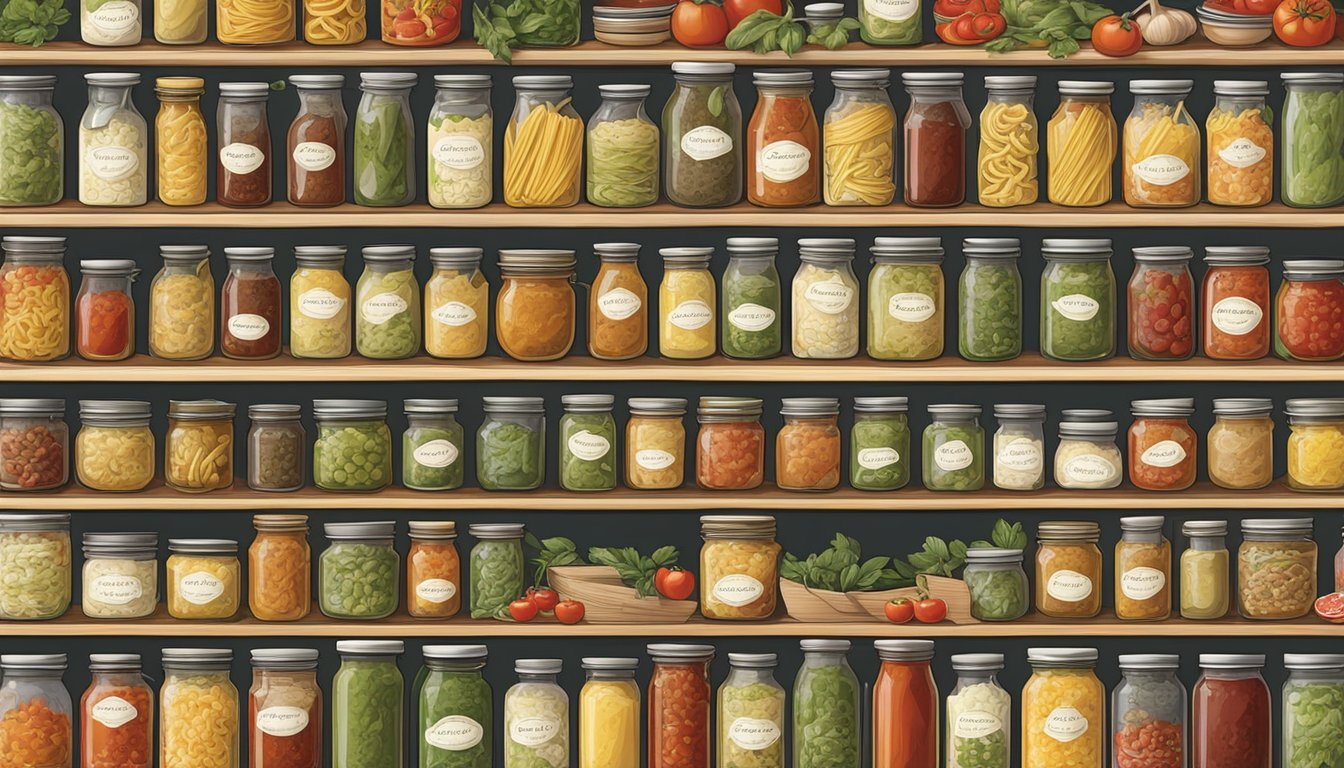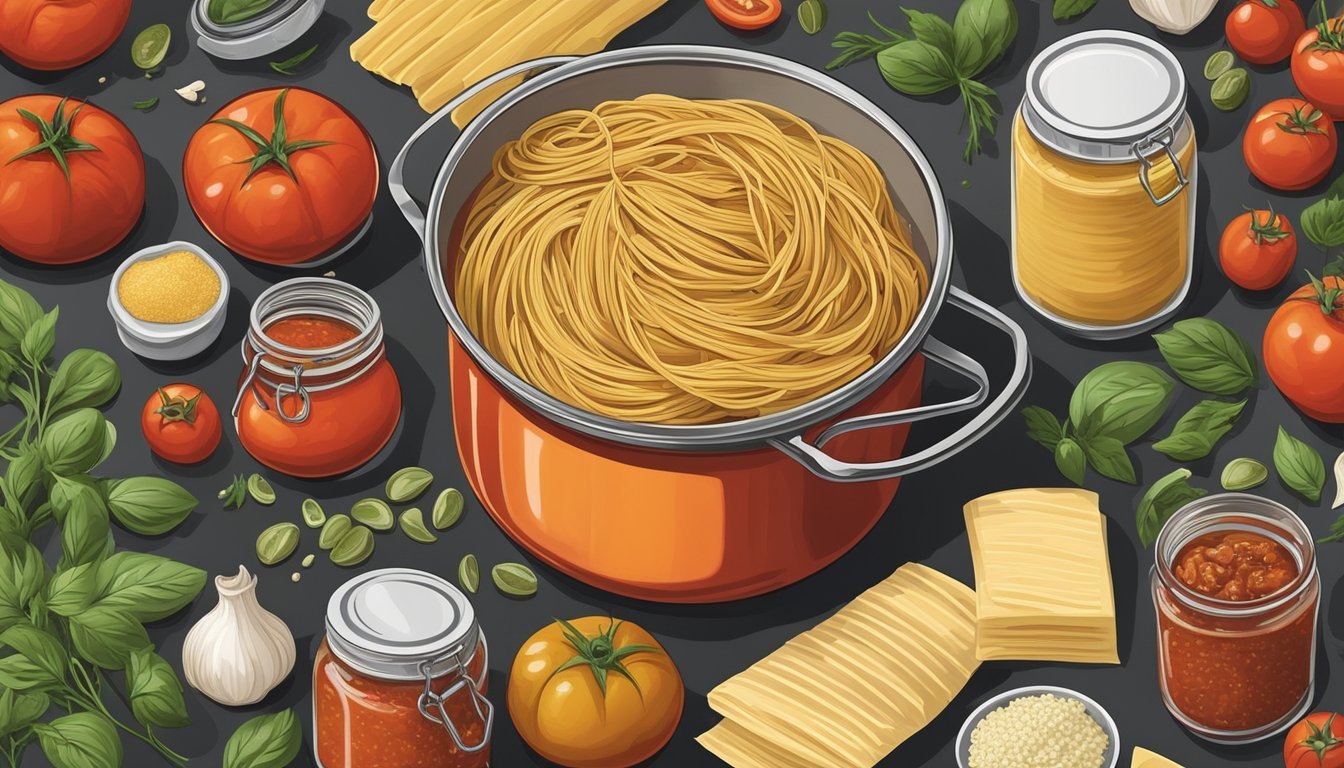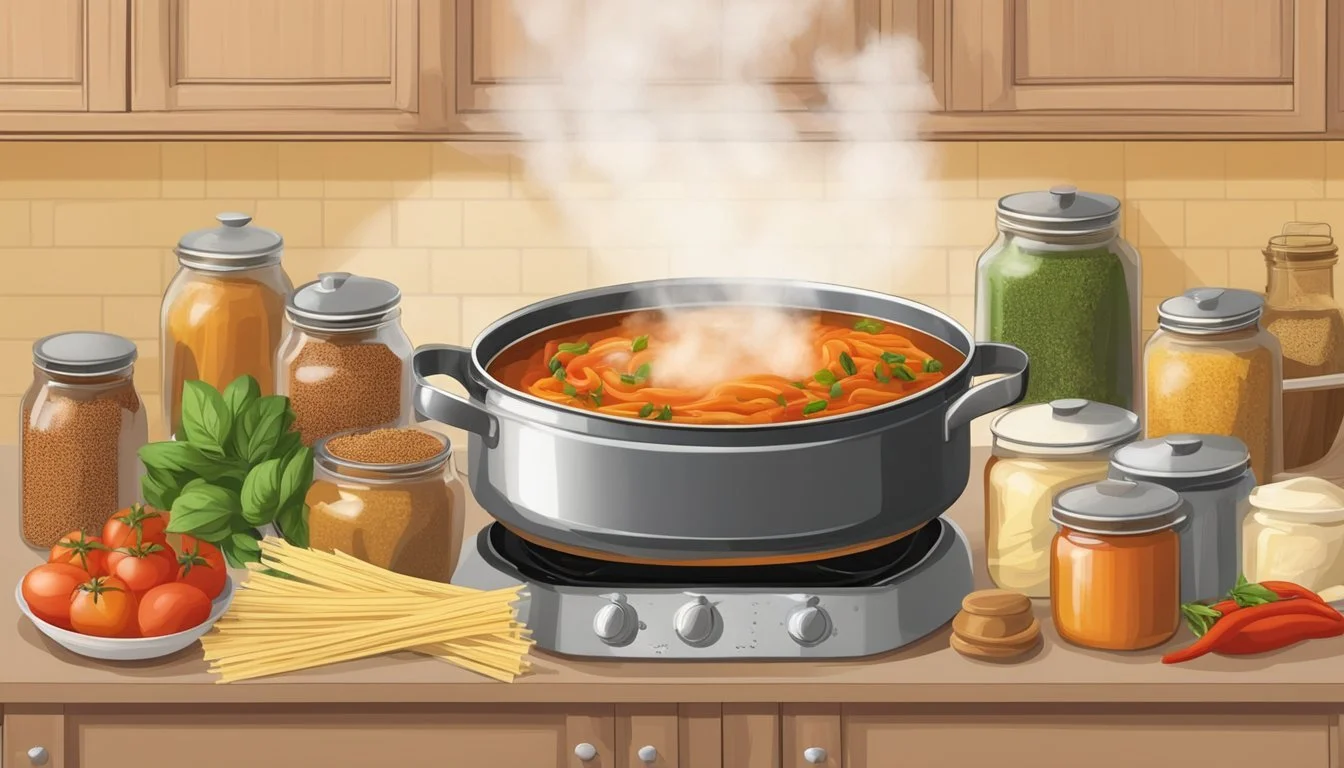Pantry-Friendly Homemade Pasta Sauce Recipes
Quick and Easy Variations
Creating a homemade pasta (What wine goes well with pasta?) sauce can be an effortless yet delightful adventure in the kitchen, turning a handful of pantry staples into a meal that exudes comfort and heartiness. Whether for a quick weeknight dinner or a leisurely weekend meal, the versatility of pantry-friendly pasta sauces ensures that a flavorful and nutritious dish is always within reach. By using ingredients like canned tomatoes (What wine goes well with tomatoes?), dried herbs, and a variety of aromatic vegetables and seasonings, one can craft a sauce that rivals store-bought varieties in both taste and quality.
The foundation of any good pasta sauce is the use of high-quality, readily available ingredients. Canned whole tomatoes, a vibrant addition to the pantry, serve as the perfect base with their rich depth of flavor that can be enhanced with ingredients like garlic (What wine goes well with garlic?), onions, (What wine goes well with onions?) and a collection of dried herbs such as oregano and basil. The inclusion of a touch of sweetness, either from a spoonful of sugar or a drizzle of vinegar, can balance the acidity and bring a harmonious complexity to the sauce.
Furthermore, personalization plays a key role in homemade sauce creation, allowing for the adaptation of recipes to suit individual tastes and dietary preferences. From the robustness of a meat-infused Bolognese to the simplicity of a garlic and oil-based aglio e olio, there's a recipe for every palate. Adaptable to vegetarian and vegan diets, these sauces can also integrate a variety of additional ingredients like olives, capers, (What wine goes well with capers?) or red pepper flakes, offering a canvas for experimentation and the joy of creating a signature dish.
Selecting the Right Ingredients
Creating a pantry-friendly homemade pasta sauce relies on the use of staple ingredients that many may already have on hand. The success of the sauce hinges on the quality and type of ingredients selected, such as olive oil and tomatoes, which serve as the foundation for a rich and flavorful result.
Identifying Pantry Staples
Key pantry staples for a homemade pasta sauce include:
Garlic and Onion: Essential for a robust flavor base.
Salt and Black Pepper: Use kosher salt and freshly ground black pepper for seasoning.
Sugar: A small amount can balance the acidity of the tomatoes.
Dried Herbs: Dried basil and dried oregano are convenient and provide a concentrated flavor.
Knowing the right combination of these staples can elevate a simple sauce to a memorable one.
Choosing Quality Olive Oil
Olive oil plays a critical role in pasta sauce, offering both taste and texture. One should select:
Extra Virgin Olive Oil: It's less processed, offering a purer flavor.
Cold-Pressed: This refers to an extraction process that doesn't use heat, preserving the oil's quality.
High-quality olive oil imparts a distinct, fresh, and fruity flavor to the sauce that can make a significant taste difference.
Opting for the Best Tomatoes
The tomato base is the heart of the sauce, so choosing the right kind of tomatoes is crucial:
Canned Tomatoes: Always have a place in the pantry and can be a great base for sauce.
San Marzano Tomatoes: These are preferred for their sweeter flavor and fewer seeds.
Tomato Paste: Can thicken and enrich the sauce.
When selecting canned tomatoes, the chef should look for ones with no added seasonings or preservatives to control the sauce's flavor profile fully.
Fundamental Techniques
In crafting a pantry-friendly homemade pasta sauce, mastering specific cooking techniques is crucial. This ensures that the fundamental flavors are fully developed and the textures are ideal. Attention to cook time and the handling of ingredients are key.
Mastering the Simmering Process
Simmering is a gentle cooking method essential in pasta sauce preparation. To correctly simmer a sauce:
Use a large pot or skillet to allow the sauce enough room to heat evenly.
A simmer is indicated by small bubbles rising to the surface of the sauce, not a vigorous boil.
Maintain a consistent temperature that allows the sauce to cook slowly and develop flavors.
The cook time during the simmering process can range depending on desired thickness and intensity of flavor, but a general guideline is 20 to 30 minutes.
Sautéing Garlic and Onions
Sautéing garlic and onions is the first step to building the savory base of the sauce. Here's how to sauté effectively:
Heat a large skillet and add a few tablespoons of extra-virgin olive oil.
Once the oil is hot, add finely chopped onions, cooking them until they're translucent—a sign they are soft and their sweetness is released.
Add minced garlic to the skillet, sautéing just until it is fragrant. This usually takes about 30 seconds, as garlic can burn quickly and develop a bitter taste.
The prep time before you add other ingredients should be minimal to preserve the fresh taste of garlic and onions.
Building Flavor Profiles
Creating a well-rounded pasta sauce hinges on the skillful layering of flavors that complement each other. It's important to understand which herbs and spices will create the desired taste profile, striking a balance between boldness and subtlety.
Italian Seasoning and Herbs
A quintessential element in Italian sauces is a mixture of Italian seasoning, often comprising basil, oregano, rosemary, thyme, and sometimes marjoram. These herbes lend a classic Mediterranean flavor to any sauce. To enhance freshness, one can also use fresh parsley, which offers a bright, herbaceous note. Here's a list of common Italian herbs used in sauces:
Basil: sweet and peppery, basil imparts a fresh lift.
Oregano: bold and earthy, often used to anchor the seasoning.
Rosemary: piney and aromatic, used sparingly for its intense flavor.
Thyme: subtle and slightly floral, complementing other herbs without overpowering.
Incorporating these herbs into pasta sauces infuses them with a taste that is unmistakably Italian.
Balancing Spices and Seasonings
To achieve a balanced sauce, the spices and seasonings need to harmonize. Salt is essential; it enhances other flavors present in the sauce. To add heat, red pepper flakes can be used according to taste preference. A dash of black pepper provides a gentle warmth and complexity.
For depth and savoriness, garlic and onion in various forms—whether fresh, powdered, or granulated—lay the necessary groundwork for a flavorful base. Garlic powder and onion powder are convenient options that infuse sauces with a consistent and controlled taste:
Garlic powder: offers concentrated, mellow garlic flavor.
Onion powder: delivers a sweet yet sharp onion essence.
Carefully measured, these spices and seasonings work together to create a sauce that is both vibrant and harmoniously seasoned.
Customization and Variations
Homemade pasta sauce is eminently adaptable. One can easily modify recipes to suit various dietary needs or preferences, ensuring that those following vegan diets or with specific dietary restrictions can still enjoy robust flavors.
Creating Vegan Options
For a vegan pasta sauce, key animal-derived ingredients such as anchovies (What wine goes well with anchovies?) can be replaced with plant-based umami sources. Olives and capers bring a depth of flavor that compensates for the absence of fish. Consider adding a dash of lemon juice or lemon zest to brighten the sauce. Utilizing vegetable stock or vegetable broth as a base rather than traditional meat broths also ensures the sauce remains vegan-friendly.
Adjusting for Dietary Restrictions
Gluten-free adaptations are straightforward: Ensure that any store-bought stock is certified gluten-free or make your own from scratch. Additionally, many who are gluten-sensitive may also need to verify that any added processed ingredients, like canned tomatoes, are free of gluten contaminants. For those avoiding certain fats or with specific vegetable intolerances, simply omit or substitute the offending ingredients with suitable alternatives, bearing in mind the overall balance of flavors.
Advanced Pasta Sauce Recipes
This section dives into complex recipes that upgrade your pasta sauce repertoire, featuring a traditional marinara, a unique take on pizza (What wine goes well with pizza?) sauce, and variations of a sumptuous meat sauce.
Classic Marinara Sauce
The cornerstone of Italian cooking, Classic Marinara Sauce, balances the richness of tomatoes with a subtle blend of herbs and vegetables. A recipe might start with a soffritto base—finely diced carrot, celery, and onion simmered until soft. Adding crushed tomatoes, a splash of red wine, and bay leaves, the sauce is then left to gently simmer, allowing the flavors to meld. A tip for achieving depth is to finish the sauce with a drizzle of extra virgin olive oil just before serving.
Innovative Pizza Sauce
An Innovative Pizza Sauce takes the familiar base of a tomato sauce and infuses it with unexpected flavors. Incorporating ingredients such as fire-roasted tomatoes can provide a smoky undertone, while a dash of white wine adds a bright acidity that complements the richness of cheese on a pizza. Herbs like oregano and basil remain essential, but one can experiment with a pinch of chili flakes to give the sauce a bit of heat.
Rich Meat Sauce Variations
Creating Rich Meat Sauce Variations involves incorporating different meats and building layers of flavor. One might start with ground beef, veal, or pork, browning it to develop a deep, caramelized foundation. A robust red wine deglaze follows, scraping up the fond for its intense flavor. Integrating a mix of minced carrot, celery, and onion adds sweetness and complexity, while a simmer with plum tomatoes and a bouquet of herbs brings the sauce together. To achieve a velvety texture, it's crucial to let the sauce cook on a low heat for an extended period, allowing it to thicken and the flavors to concentrate.
Cooking and Pairing with Pasta
When creating homemade pasta sauce, the cooking of pasta and its pairing with the right type of sauce are crucial to the success of a dish. The key to perfect pasta lies in achieving "al dente" texture and knowing which pasta shapes best complement the consistency and flavor of your sauce.
Achieving the Perfect Al Dente
Al dente, translating to "to the tooth" in Italian, refers to pasta that is cooked to be firm to the bite. Achieving this texture begins with bringing a large pot of salted water to a rolling boil. For every pound of pasta, use about 4 quarts of water and 1 tablespoon of salt. Once the water is boiling, add the pasta and start timing as per the package instructions. It's crucial to stir occasionally to prevent sticking.
One should start testing the pasta about 2 minutes before the indicated time is up. The ideal al dente pasta should still have a tiny white core in its center when bitten into. This texture ensures the pasta will still have some bite and structure after it has been mixed with the sauce. For sauces that will simmer with the pasta (like a Bolognese), slightly undercook the pasta by 1-2 minutes since it will continue to cook in the sauce.
Choosing the Right Pasta for Sauces
The pasta shape matters when it comes to sauce pairing:
Spaghetti: Ideal for lighter, oil-based sauces which coat the thin strands evenly.
Ziti: A tube-shaped pasta that goes well with thicker sauces, the ridges and holes allowing the sauce to adhere well.
Lasagna: Its wide, flat shape is designed to layer with rich, hearty meat sauces and cheeses.
When experimenting with pasta and sauce combinations, consider the following:
Sauce Consistency: Heavier, meaty sauces work best with shapes like penne or rigatoni, which have nooks and crannies for trapping the sauce.
Flavor Integration: For thinner, more delicate sauces, opt for long, slim pasta like spaghetti or angel hair, which balances the sauce so that it doesn't overpower the pasta.
Remember, when one drains the pasta, a bit of the pasta water should be reserved. This starchy water can be used to adjust the sauce's consistency, helping it to cling to the pasta more effectively.
Preservation and Storage
When it comes to preserving homemade pasta sauce, one can extend its shelf-life by refrigerating or freezing, ensuring that the sauce's flavor and quality are maintained until it's ready to be enjoyed.
Refrigerating and Freezing Tips
Refrigeration:
Shelf Life: Homemade pasta sauce typically lasts in the refrigerator for 3-4 days.
Storage Containers: Use an airtight container or glass jar to inhibit mold growth and retain freshness.
Temperature: Keep the sauce below 40°F to prevent bacterial growth.
Freezing:
Freeze Time: Sauce can be frozen for up to 4-6 months.
Containers for Freezing: It's advisable to use freezer bags or airtight freezer containers to prevent freezer burn.
Thawing Process: Thaw overnight in the refrigerator or use the microwave's defrost setting for quicker results.
Best Practices for Reheating
Consistency Maintenance: When reheating, one may add a splash of water or broth if the sauce has thickened too much during storage.
Heating Method: Reheat on the stove over medium heat, stirring frequently to avoid burning.
Microwave Reheating: If using a microwave, cover the sauce to avoid splattering and reheat in short intervals, stirring in between.
Serving and Presentation
The visual appeal and taste of homemade pasta sauce are greatly enhanced by the right garnishes and the use of appropriate utensils for serving.
Garnishing with Cheese and Herbs
Cheese: A generous sprinkle of Parmesan or Pecorino Romano cheese not only adds a nutty and salty flavor to the pasta but also creates an inviting appearance. These hard cheeses, when finely grated, melt slightly over the hot sauce, enriching its texture.
Parmesan cheese, known for its robust flavor, is commonly used.
Pecorino Romano, a sharper and saltier alternative, can also be employed to accentuate the sauce's taste.
Herbs: Freshly chopped herbs such as basil and parsley not only provide aromatic freshness but also add a pop of color that enhances the visual appeal of the dish.
Basil lends a sweet and slightly peppery taste.
Parsley offers a clean and slightly bitter note that can balance the richness of the sauce.
Proper Use of Cooking Utensils
Tongs: To serve spaghetti with homemade sauce effectively, one should use tongs. These allow the cook to grip the pasta firmly, facilitating the twist and lift method to plate spaghetti without it slipping back into the bowl.
When transferring the pasta to a plate, tongs help incorporate the sauce, ensuring each strand is evenly coated.
Remember, the final presentation is not only about taste but also about creating a visually appealing plate that invites diners to enjoy the meal.
Special Dishes Utilizing Pasta Sauce
Pasta sauce is not only for spaghetti; it transforms ordinary ingredients into culinary sensations. Here are innovative ways to have homemade pasta sauce play the starring role in a variety of dishes.
Preparing Lasagna Layers
When assembling lasagna, the sauce is the element that unifies the layers. One should spread a thin layer of marinara on the bottom of the baking dish, followed by a sequence of lasagna noodles, ricotta cheese mix, shredded mozzarella, and repeat. Ensuring each layer is generously coated with sauce guarantees a moist and flavorful result.
Shakshuka with a Twist
Shakshuka traditionally features a poached egg in a savory tomato sauce. For a hearty twist, one can simmer eggs in a hearty pasta sauce enriched with roasted bell peppers or olives. The pasta sauce should be heated until it bubbles gently before carefully adding the eggs to poach to creamy perfection.
Baking Flavorful Pizza
Homemade pizza sees its foundation in a robust pasta sauce. After rolling out the dough, chefs brush it with olive oil and then spread a layer of seasoned tomato sauce, leaving room at the edge for the crust. A sprinkle of Italian herbs on the sauce before adding toppings can elevate the flavor profile.
Comforting Ziti Bake
For an irresistible ziti bake, pasta is tossed with a combination of alfredo and marinara sauce, creating a rich, pink sauce. The ziti is layered with sauce, ricotta, and plenty of mozzarella cheese, then baked until bubbly and golden. Multiple sauces in the dish introduce a depth of flavor, making it a comforting favorite.
Nutritional Information and Tips
When crafting homemade pasta sauces from pantry staples, one should consider both the nutritional impact and the palate-pleasing aspects of the ingredients used. A balance between health benefits and flavor can create a sauce that not only satisfies taste buds but also supports overall wellness.
Consulting with a Professional Nutritionist
Nutrition is a complex field, and tailoring a pasta sauce to meet specific dietary needs may benefit from consulting a professional nutritionist. They can offer personalized advice on incorporating nutrient-dense ingredients without compromising taste. For example, a nutritionist can suggest using olive oil for healthy fats, adding anchovies for omega-3 fatty acids, and including a variety of herbs for antioxidants.
Ingredient Nutrient Benefit Olive Oil Monounsaturated fats Anchovies Omega-3 fatty acids Herbs Antioxidants
Balancing a Healthy Diet with Flavor
Adults seeking to infuse their diet with more flavor can do so without sacrificing nutritional value. Incorporating ingredients such as garlic and onions can add taste and provide health benefits like improved heart health. To boost a sauce's nourishing profile, one could choose whole, minimally processed tomatoes and use herbs for seasoning instead of high sodium alternatives.
Garlic and Onions: Contain compounds beneficial for heart health.
Tomatoes: High in vitamin C and lycopene, especially when cooked.
Herbs: Great for adding flavor with minimal calories and health benefits.
In preparing a pasta sauce, it's essential to monitor portions of ingredients like salt and fats to prevent inadvertently creating a dish that's counterproductive to one's health goals.
Kitchen Equipment and Efficiency
In the realm of homemade pasta sauce, using the right kitchen equipment can streamline the cooking process and enhance the overall flavor and texture of the sauce.
Essential Tools for Sauce Making
Large Skillet/Pot: For home cooks looking to craft pasta sauce, a large skillet or pot is paramount. These vessels provide ample space for ingredients to simmer and flavors to meld. In terms of size, a skillet or pot with at least a 12-inch diameter and deep sides is most effective. It allows for sautéing aromatics such as garlic and onions, and for cooking down tomatoes without splattering.
Skillet: Ideal for quick, pan sauces that incorporate fresh ingredients and are best served immediately.
Pot: Best for longer simmering sauces that develop depth of flavor over time.
When selecting a skillet or pot, one should opt for heavy-bottomed cookware as they distribute heat more evenly, preventing the sauce from burning.
Utilizing an Immersion Blender
An immersion blender serves as a versatile tool in sauce-making, providing efficient blending right in the pot. Suitable for puréeing tomatoes to a smooth consistency or incorporating ingredients seamlessly, the immersion blender eliminates the need for transferring hot sauce to a blender or food processor.
Here are specific ways an immersion blender can be used in sauce preparation:
Texture Control: It allows the cook to choose the sauce's texture, from rustic and chunky to smooth and velvety.
Time-Saving: Blending directly in the cookware means less cleaning and more time saved.
For those without an immersion blender, a traditional blender can still be used, but one must be cautious when blending hot liquids. A tip to ensure safety is to allow the sauce to cool slightly and to blend in small batches, to prevent pressure buildup that can lead to spills or burns.
Time-Saving Tricks
When it comes to preparing homemade pasta sauce, efficiency is key. These tips ensure one spends less time in the kitchen while still delivering delicious flavors.
Quick and Easy Sauce Hacks
Utilize pantry ingredients: Items like canned tomatoes, garlic, olives, anchovies, and capers can be combined to create a sauce that saves time without sacrificing taste.
Sautéing for speed: To infuse flavor quickly, one can start by sautéing garlic and onion before adding the main ingredients.
Dissolvable elements: Adding ingredients such as anchovies to the hot oil allows them to dissolve, deepening the flavor rapidly.
Pre-mixed seasoning: Keep a pre-mixed bottle of Italian seasonings to avoid measuring out individual herbs each time.
Make-Ahead Strategies for Busy Cooks
Batch cooking: Cook a large quantity of sauce and freeze it in portions. This makes it easy to thaw exactly what one needs for a meal.
Pre-cooked meats: Brown meats such as ground beef or sausage ahead of time, drain, and store in the refrigerator to be added to the sauce later.
Oven roasting: Ingredients like tomatoes and garlic can be roasted in bulk and preserved in the freezer to expedite the sauce-making process later on.
Refrigerate overnight: Some sauces benefit from a night in the refrigerator, as flavors meld and deepen, making it a perfect make-ahead option.
Enhancements and Final Touches
To elevate pantry-friendly pasta sauces, incorporating fresh ingredients and integrating vegetables can marvellously transform their taste and texture. These final touches not only add a burst of flavor and color but also increase nutritional value.
Adding Fresh Ingredients for Pop
Sprinkling fresh parsley into a pasta sauce can infuse it with a bright, herbaceous pop. Lemon zest and a squeeze of lemon juice can add a refreshing zing that cuts through the richness of the sauce. They can be particularly effective in enhancing tomato-based sauces (What wine goes well with tomato-based sauces?) or creamy Alfredo types, bringing in a layer of complexity and freshness.
Utilizing Potatoes and Vegetables
Diced potatoes can be simmered within the sauce to add a hearty element, thickening the sauce naturally while also absorbing its flavors. For added health benefits and texture, one could stir in some spinach, which wilts quickly and melds seamlessly into sauces without overpowering the base flavor.
Add 1/4 cup of finely chopped parsley for freshness.
Incorporate 1 tbsp of lemon zest and 2 tbsp of lemon juice for brightness.
Mix in 1 cup of diced potatoes for heartiness.
Fold 2 cups of fresh spinach leaves into the sauce until wilted for a nutritional boost.
Beyond Pasta: Other Creative Uses
When considering pasta sauce, it is often pigeonholed as a simple accompaniment to noodles. However, its versatility extends far beyond pasta dishes. One can utilize pasta sauce as a foundation for various culinary creations, from hearty bakes to innovative fusion dishes.
Pasta Sauce as a Base for Other Dishes
They can start by using pasta sauce as an alternative base in numerous recipes. For example, pasta sauce can easily transform into a flavorful ratatouille (What wine goes well with ratatouille?). Simply chop vegetables like bell peppers, zucchini, onion, and eggplant, and bake them in pasta sauce diluted slightly with water until tender, creating a rich, rustic dish perfect for a hearty meal.
Moreover, a simple cast iron pizza gains depth with a base of robust pasta sauce, eliminating the need for separately prepared pizza sauce. An application of pasta sauce below a layer of mozzarella and chosen toppings, followed by a spell in a hot oven, results in a gourmet homemade pizza.
Fusion Recipes with a Pasta Sauce Twist
They can introduce a novel twist to traditional meals by infusing them with pasta sauce. One could take inspiration from Italian flavors to create a fusion dish such as red wine pasta. Toasting pasta to a golden brown before cooking it in red wine and pasta sauce adds a nuanced flavor profile and enticing color. This technique works exceptionally well with robust, textured sauces that cling to the pasta, offering a delightful dining experience.
In baking, pasta sauce can also be an integral part of the dish. For instance, when preparing stuffed chicken breasts, a spoonful of pasta sauce inside or layered on top before baking provides moisture and an extra punch of flavor. As the chicken bakes, the sauce infuses into the meat, creating a succulent and flavorful meal.
The adaptability of pasta sauce in the kitchen is only limited by one's creativity. Whether it's through the enhancement of vegetables, the creation of comforting home-baked pizzas, or the initiation into fusion cuisine, pasta sauce proves to be an indispensable ally in diverse culinary exploits.
Conclusion
Creating homemade pasta sauce with pantry staples is both accessible and gratifying. A well-stocked pantry can provide the basis for a variety of sauce recipes tailored to individual tastes and dietary preferences. With ingredients like olive oil, garlic, canned tomatoes, and a selection of herbs and spices, one can craft a sauce that rivals those found in many restaurants.
Recipe flexibility is a significant advantage when making pantry-friendly pasta sauces. One can adjust ingredients based on availability; for example, anchovies might be omitted or substituted with olives or capers for a briny depth of flavor. Similarly, the heat level can be customized by adding red pepper flakes to one's desired intensity.
The convenience of these sauces can't be understated—they can be prepared in advance and stored, ensuring that a homemade meal is never too far out of reach. Even with a tight schedule, a nourishing and flavorful sauce can be simmered in the time it takes to boil pasta.
Here is a basic guideline for creating a simple tomato-based pasta sauce:
Begin with a base of sautéed garlic in olive oil.
Incorporate canned tomatoes, crushing them if whole.
Season with salt, pepper, and Italian herbs such as basil or oregano.
Simmer until the flavors meld and the sauce thickens to the desired consistency.
Enhance the sauce with additions like cooked onions, carrots, or red wine for complexity.
Through this approach, one can achieve a balance between ease, taste, and nutrition, turning an ordinary pasta dish into a delightful culinary experience.

